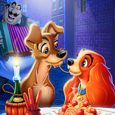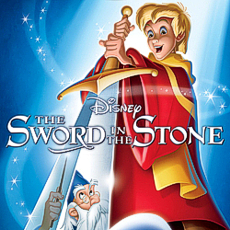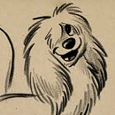Walt Disney Productions (June 22 1955), Walt Disney Home Entertainment (February 28 2006), 2 discs, 76 mins plus supplements, 2.55:1 anamorphic widescreen, Dolby Digital Surround, Rated G, Retail: $29.99
Storyboard:
Set in 1910, Lady And The Tramp finds us in small town America as Christmas draws close. Jim Dear (voiced by television regular Lee Millar) presents his wife with a hatbox, from which the adorable pup Lady (actress Barbara Luddy) pops up, and Jim’s wife Darling (singer Peggy Lee) is smitten. Lady soon has the run of the house, making good friends with neighbours Jock (long time Disney voice Bill Thompson) and Trusty (Bill Baucom, later of many other television outings). When the stork drops off a present for Jim and Darling, Lady must take second place to the baby, something she has trouble accepting, especially when Aunt Sarah (another Disney regular Verna Felton) arrives to help out and takes an instant dislike to having a pooch around. Into Lady’s life comes Tramp (Larry Roberts), a mongrel from quite literally the wrong side of the tracks. His devil may care and streetwise attitude excites Lady and, much to Jock and Trusty’s chagrin, she runs off with him after a particularly nasty moment with Aunt Sarah’s cats Si and Am (Lee again).
Out in the free, Lady and Tramp draw closer together during the course of their adventures, which see a dangerous scrap with some other street dogs, a comical aside with a rather confused beaver (animation voice and comedy legend Stan Freberg) and, of course, the most famous romantic image not only in all of Disney, but one that has made a significant contribution to the entire film world – Lady and Tramp’s candlelit dinner at Tony’s restaurant, where spaghetti and meatballs create the perfect romantic movie moment. But idyllic bliss can not remain forever, and Lady is soon caught and sent to the pound, where she finds out what a dog Tramp truly is from his old friends (DisneyLand recording artists The Mello Men) including one-time companion Peg (Lee again, singing the film’s breakout song, He’s A Tramp). When Lady’s registered collar lets her off the leash and Tramp turns up at her home again, she understandably attempts to drive him off her turf, but Tramp has seen lurking danger in the form of an evil looking rat who seems intent on causing the Dears’ baby distress. The exciting climax sees Tramp, Jock and Trusty in a race against time that could save the baby, but might also set a certain path to doom for Tramp…
The Sweatbox Review:
Although the rise of Mickey Mouse and the introduction of Disney’s stable of characters and the first animated feature length film often contributes to the marking out of the 1930s as animation’s Golden Age, the 1950s could arguably be labelled the Studio’s most prolific. With a return to full-length feature cartoons after the break of World War II, Disney saw the release of Cinderella, Alice In Wonderland and Peter Pan within the first three years of the decade. Add to this Walt’s move into television, spearheaded by a Wonderland Christmas special, followed by The Mickey Mouse Club and the weekly anthology series DisneyLand, mixing both original content such as the Davy Crockett phenomenon and often peeking behind the scenes of his animated and live action films of the time, which included his first true live-action film Treasure Island and the epic adventure 20,000 Leagues Under The Sea. Of course, the DisneyLand show also provided publicity and a way to fund another Disney project, the theme park itself – all of which seemed to come together in the same year that Marty McFly time travelled to in Back To The Future…1955.
This same year saw the summer release of Lady And The Tramp, the Studio’s first officially self-penned story since 1941’s Dumbo and one that was especially close to Walt due to its turn of the century American small town setting that evoked his home town of Marceline (also reflected in the park’s Main Street entrance). Lady And The Tramp’s origins have been steeped in rumor over the years, with perhaps the most publicity-friendly being the story that Walt once presented his wife Lily with a pup in a hat box the way Lady is brought into the Dears’ lives. Although the story has always been taken with a pinch of salt, the supplements here delve deeper, revealing the actual impetus for the film, its journey through re-writes and Studio-sponsored book form, and finally into a screenplay that became one of Walt’s most admired, and adult, animated films.
Yes, adult. By this I mean the mature tone of the film, the fact that is has been exceptionally realized from the view of our characters’ canine eye level, and that it is at heart a true love story, filled with the kind of mischief and comedy that one would expect from Disney, but brought down a notch or two to really let the story and the characters’ emotions shine through. The writing is superb, inviting a genuine real-world mentality into the script and how the characters’ lines are delivered. Although this is a dog’s story, it’s a story that hasn’t gone to the dogs, being a very well observed drama about as close to “kitchen sink drama” as one could attempt to describe a Disney confection.
Likewise the animation is up to scratch, being among the most delicately handled of all Disney’s features, coming after the knockabout and adventurous fantasies of Alice and Peter Pan, respectively, and just before the ambitious Sleeping Beauty, perhaps the zenith of the Disney-styled fairytale picture. Walt’s Nine Old Men certainly pulled out all the stops in their cartooning of the canine stars and though one never forgets one is watching a cartoon, the whole look smacks of authenticity both in the designs and the deep, lushly painted backgrounds. The editing is also less frantic than we may be used to in animation, due in part to the story, and also in helping the wider frame sustain interest where constant cross cutting would feel clumsy and too erratic. These wider vistas also give the animators room to breathe – more than once you’ll notice that the camera often stays fixed and it is the characters’ movements that keep things ticking along, just as in a live action setting.
Perhaps this calmer atmosphere was a reaction to Alice In Wonderland, which had garnered much criticising of its haphazard zaniness, and the fact that the story was fresh and new (based in part on Ward Greene’s Happy Dan The Whistling Dog And Miss Patsy The Beautiful Spaniel, written directly for the Studio) allowed more scope without being bogged down by preconceptions from famous books. There is certainly a less rambunctious air about Lady And The Tramp than in other Disney films, and the usual fantasy world of animals conversing with humans is shied away from, with each species only speaking to and being understood by their own kind, a concept I can’t recall being repeated to any extent until the recent Brother Bear.
There’s also the obvious love story aspect about it all, too, being one of the Studio’s most realistic relationships – dogs or not! As Tony the cook mentions to Tramp during the film’s signature Bella Notte number, “You settle down with this-a one, eh?”, referring to Tramp’s reputation. For another thing (and as Feature Animation producer Don Hahn points out in the extras), the Studio artfully but respectfully conveyed the fact that young lovers do mate – and this yet even before marriage and in the confines of conservative American 1950s moviemaking, an often overlooked touch when one thinks of Disney as being just for kids.
Which brings us to the much relied on for suspense theme of death in the movie. Tramp, of course, lives in fear of the dog catchers, despite being a scallywag and lovable “dog about town”, while Peg and the boys in the pound have obviously led dubious lives in the past and do not face much future. Apart from their moment to shine, built around Peg’s He’s A Tramp sequence, the dogs appear solely for the reason to fill Lady in on Tramp’s womanising life, and to set up the third-act’s “ticking clock” danger. But they add so much more, again bringing to the fore the unspoken but fairly obvious fact that these pooches won’t probably last out the week – something instantly made aware to adults as flea-ridden Nutzy is led away through the “one-way door”. Kids more than not will be oblivious to this – they’ll seem to think that the pound is a pretty fun place and that the Mello Men sing there still. Peg herself seems to be something of a pooped-out showdog, someone who has been there and done it all, and imparts her words of advice about Tramp to Lady as a take-it-or-leave-it weary conquest, as her melancholy song plays out.
Perhaps the only moment that doesn’t ring quite true is paradoxically one of the film’s most remembered, the Siamese Cat Song, as sung by Peggy Lee in the dual roles of Aunt Sarah’s felines Si and Am. Into this fairly straight dramatic story come these two mischievous moggies who upset not only Lady’s life, but also to an extent the balance of the movie. Theirs is the only truly kid-friendly segment – often repeated on Disney clip shows – and brings a sense of comedy to the picture. The artists have fun with the gags, and the lyrics are full of clever wordplay, but to be honest the sequence never quite fit for me. The cats come and go too quickly – we really neither care where they came from nor what happens to them. If they had been a bigger part of Lady’s life – perhaps as a continuing interference – then they would have registered more in their role in getting Lady in to trouble. As I mention though, they never really did it for me, and despite their comic asides, I have never been able to see them for much more than that and theirs is the weakest, most extraneous moment in Lady And The Tramp.
To pick on this aspect too much is to miss the point however. Lady And The Tramp is not only one of Walt’s most sophisticated films – on many levels – it is also one of filmmaking’s masterpieces, sadly overlooked more often than not in the general consensus. It’s full of inventive ways of storytelling (Lady’s growing “overnight” to show the passing of time, the visual shorthand use of shadows and the rainstorm during the film’s most suspenseful sequences), which may feel somewhat clichéd nowadays, but was thrilling at the time – the silhouette of the rat against a lightning bolt towards the end surely still drives up the peril factor and excites. Some critics have taken the overt realism of the film to task, but for me there’s nothing like telling a story like this in animation. The medium serves up the kind of clean world we can only remember in memories, while how else would one get its cast to act accordingly in scene after scene other than by the currently in vogue technique of computer animation, something that would scream of vulgarity in attempting a subtle story such as this by comparison.
Lady And The Tramp on reflection, and as this superb DVD showing reveals, is a much more intricate and rewarding film than one might be expecting or indeed remember from growing up. It could only have ever been told in animation, and by the team of animators and voice cast members here. In a funny way, I always pictured Tramp as a Dean Jones type, and even though the actor never voiced an animated creation at the Studio, there’s more than a hint of Dean in Tramp’s design and vocal reading. Likewise Lady And The Tramp is an important milestone in the Disney canon as it marked an end to the fairytale formula and introduced variety into animated features. The use of Peggy Lee could also arguably be the first time a superstar voice was used in a cartoon film – Disney had often used radio personalities (the most famous of which was probably Edgar Bergen), but Lee was a bona fide star well in her own right when Walt persuaded her to join the cast.
Some more esteemed critics than myself have levelled claims against the “static cartooning”, or the overly “sterile look” in the past, but surely that’s part of the film’s charm in recreating a world recognisable as our own, but different enough to place the characters in their own land. Either way, Lady And The Tramp is pure gold Disney, and as close a tribute to man’s best friend as any could hope for.
Is This Thing Loaded?
As a Platinum release, Lady And The Tramp has a fair bit to live up to after the disappointingly light Cinderella set from last year. For the most part, this edition just about raises the bar a little, but there’s nothing here that approaches the sheer fan wallowing that a Snow White, Bambi or Aladdin have provided in recent releases.
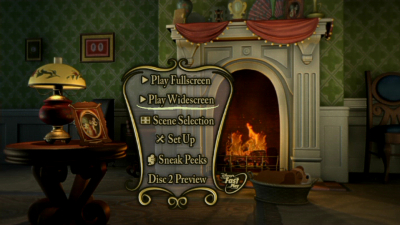
The disc – predictably – kicks off with a series of Sneak Peeks that run automatically as part of Disney’s non-interactive Fast Play system or selectable from their own menu. Among the previews here is a “brand new, exclusive” look at the Brother Bear 2 follow-up, with Rutt and Tuke trying to convince the audience that they’re actually watching Lady And The Tramp. The start of the clip is fun, but it will soon become apparent to animation aficionados that there isn’t a frame of new animation here as there were in the special previews that the pair featured in for the original Brother Bear. All that’s been done here is a simple cut-and-paste dub job, with suitable shots (check out those changing sequence backgrounds) from the sequel re-dubbed by Rick Moranis and Dave Thomas and not particularly well in terms of lip-synch. A nice idea, and a nice variation on the usual same old trailers, but it could have been a little “more”.
Other previews jostling for your attention include a first look at The Little Mermaid’s Platinum Edition (coming this fall), a behind the scenes peek at The Shaggy Dog, Chicken Little’s DVD, AirBuddies, a new “Special Edition” of Dumbo, a generic Disney World clip, and a new “Special Edition” for the adequate DTV sequel Lady And The Tramp II: Scamp’s Adventure which looks only to bundle in a new game and music video over its previous release. I’d love to say that there’s an entire second version of Lady And The Tramp as a bonus in its original Academy format (see below), but alas, that is the not case! So, apart from the widescreen feature and the previews, the rest of Disc One is taken up by a waste of space pan-and-scan full-screen version of the main feature (be aware that the Fast Play route plays this hack job by default), and all else that resides on disc one is a half-hearted attempt to drum up interest in Disc Two with a montage of images from the features coming up.
And speaking of which…on to Disc Two, which is segmented into four sections, the first of which is Deleted Scenes. A helpful touch often (but not always) provided by some Disney DVDs is inclusion of the running time in the selectable highlights, and a Play All option here that reveals a 12:55 play length. Aladdin animator Eric Goldberg seems to serve as an unofficial host for the entire DVD, and he pops up here with an Introduction to the scenes, which include Turning The Tables (an overlong, but whimsical abandoned concept that saw the dogs keeping their human owners as pets in a very literal sense) and The Arrival Of The Baby (an alternative concept that slightly extends the Dears’ expecting plans leading into a longer La-La-Lu song sequence). Finally acknowledging that general movie viewers must have some inkling of what a storyboard is, Goldberg skips the “it’s like a comic strip panel of the movie” talk and gets right to specifics. Both scenes are bookended by footage that shows where they would have been placed in the finished movie, and the new voice actors’ (uncredited here) recreations sound almost spot on in their respective roles.
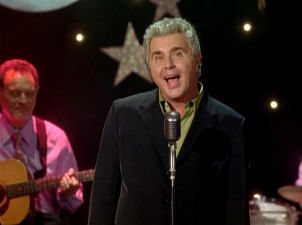
Moving into the Music And More section, and Goldberg again intros The Siamese Cat Song: Finding A Voice For The Cats, a 4:20 featurette on the development of one of the film’s most memorable moments and how it was originally intended to be performed by two male singers. We see early storyboard concepts and hear demo recordings, and should be thankful for their inclusion, since they could be misconstrued as being rather stereotypical in any day and age! Sticking around here offers up a pointless Bella Notte music video, not by Peggy Lee, but by singer Steve Tyrell, who coincidentally, I believe, has a Disney album out around now. It’s a pretty par-for-the-course clip, running 2:55 and mixing live-band studio footage with animation from the film, though to be honest, and while the slow jazz version of the song is pretty smooth, I found Steve quite scary!
Heading into Games And Activities, there’s a quick plug for the Adopt A Virtual Puppy DVD-ROM section (more on that below), as well as Disney Dog Trivia, a “virtual board game” that offers up a great deal of fun. I recommend the “Family Edition”, since the board game is on view (as opposed to the question-only single player version) and the questions are more varied (I got the same one twice in a ten question game). Careful though, since some of the answers are questionable, as I am sure that the dog in Mary Poppins led them to Uncle Albert’s, even though this was supposedly wrong.

DisneyPedia: Going To The Dogs looks back over the history and types of dogs, with Disney clips mixed in with current real world pooches and their owners, hosted by comic actor Fred Willard, a very funny man who has commentated on canines very amusingly before in Chris Guest’s mockumentary (or should that be dogumentary?) feature Best In Show. The clip only runs 9:20, but is strangely chapter marked with several indexes! Finally, Your Inner Bark is a personality profile that asks questions and works out which of the film’s characters you are most like – for the record, I came in as the respectable but fun Jock!
Bringing more meatballs to the table is Backstage Disney – surely the first stop for collectors who want to know the real ins and outs of Disney’s films. Here you’ll find the seven-part documentary Lady’s Pedigree: The Making Of Lady And The Tramp, which runs over 52 minutes if selected as a Play All option. The piece runs though Walt’s early years in Marceline, Missouri, and its inspiration for Lady And The Tramp’s setting, the development of the story, its path through animation, scoring, voice recording, and the film’s artistic style. An epilogue wraps things up nicely and reminds why Lady And The Tramp still pleases after all these years.
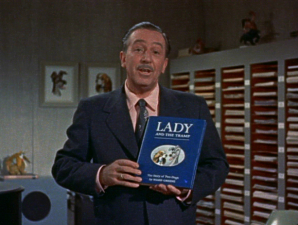
It’s a very nice documentary, as professionally put together as any yet seen on a Disney LaserDisc or DVD release, and there’s a great amount of archival footage of both Walt returning home and of the film’s production. While one might hope that interviews with the original animators might have been conducted before their passing (Ollie Johnston, briefly seen here, is the last remaining of Walt’s original Nine Old Men), that is not the case and instead we hear about how the new crop of Disney artists have responded to the film over the years. Two television specials are plundered for behind the scenes material, and while this leads to much repetition a nice touch is that both of these are excerpted at length elsewhere here, so it’s not a case of one or the other. Extensive use of production photographs add to the retrospective feel, while best of all is Frank Thomas’ home movie footage taken to explore the movements of the family dog. Less satisfactory is the fact that the full-frame Academy edition of the film (see below) is referenced and discussed, without that version being made available anywhere on the disc!
Finding Lady: The Art Of Storyboards is a look at this much shown and historically important development by Walt Disney and its place in the film process. This is a good overview of the form’s backstory, but it doesn’t really have anything to tie it specifically to Lady And The Tramp apart from brief mentions which, really, could have come from any Disney feature (there’s actually more focus on Beauty And The Beast). From host Eric Goldberg, we hear how Walt used storyboards to keep everybody involved in production on the same page and how the process was picked up by others (most notably Hitchcock), while the filmmakers of today are dubiously represented by Kevin Costner in director mode, who explains via clips from the (Disney) movie Open Range how he set up his shots and found boarding sequences to be a worthy tool. While this has nothing to do with the main movie (and I did wonder if Costner’s footage had been culled from some Open Range press kit material), he does pay direct tribute to Walt, so this appears to be fairly recently shot for this release. Studio “synergy” rears its head by having director Andrew Adamson chime in with similar comments, though he’s obviously there more to slip in some Narnia references rather than to impart any real info. As a history of storyboarding, this 13 minute piece does its job well, however familiar we are with this method of pre-production (“storyboards are like a comic strip”), and informs with the minimum of fuss.
Leaving the doc running automatically leads in to Original 1943 Storyboards, a run down of a much earlier, more contemporary version of the story with Eric Goldberg and long-time Studio story artist and director Burny Mattinson. The pair have the original boards pinned up and walk through the scenes as they would if they were pitching the film to their colleagues. While this is very fun (Tramp’s name skipped between Homer and Bozo at this time, while the Siamese Cats were Nip and Tuck), and a most welcome inclusion, what about if they had recreated the entire film and recorded dialogue to reconstruct a full alternate version – how cool would that have been? It certainly would have been more preferable to have that and lose the pan-and-scan edition of the movie, and might have echoed the awesome feature that was Walt’s Story Meetings on the Bambi DVD. Still, this does what it does in a cute fashion, with music and sound effects livening up the delivery. The 12-minute piece is also selectable from its own menu option.
Moving on and we come to Excerpts From DisneyLand TV Shows – now THIS is why supplemental feature fans have got to love Walt Disney. He was making DVD extras – albeit of the rather cheesily staged kind in this day and age – over 50 years ago! Talk about looking ahead! The two shows lengthily excerpted here are A Story Of Dogs (from December 1954) and Cavalcade Of Songs (from the February of 1955). As usual, we don’t get the entire, fully uncut versions of these shows, but A Story Of Dogs may be familiar to those with The Complete Pluto set in the Walt Disney Treasures line, since the parts relating to Mickey’s pooch in that show were presented in those bonuses. But what we get here is very cool stuff – probably my most favorite extras in the set and the most likely to be revisited. And, making the selection even better is that fact that the sequences shown here have been reconstructed from original color negatives that have been matched up to the final, black and white master cut of the show. In a four-minute introduction, Goldberg explains that as a result the image quality may vary throughout the programs, but I didn’t notice any unexpected or truly distracting anomalies and seeing this footage in color far outweighs any technical inconsistencies.
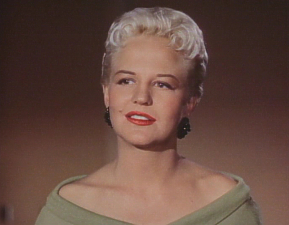
First up is A Story Of Dogs, which originally took the viewer through Disney’s canine history with Pluto and then went on to introduce the stars of his latest, upcoming feature Lady And The Tramp. The 17:30 running section is simply charming, with many of the original crew on hand to explain their role in the making of the picture, including a potted storyboard version of the story, the work of the layout boys, pencil test footage, original recordings sessions and footage of the legendary Frank Thomas and Milt Kahl in action, animating their scenes – what more could anyone ask for? Something on the movie’s songs? Well, Walt has you covered there too, which dovetails nicely and brings us to…
Cavalcade Of Songs, the second excerpted show, also originally contained more footage, namely a look back at some of the highlights in Disney’s song catalog, which was pretty vast even then. The sections retained here, running 21:40, concentrate solely on the songwriting process for Lady And The Tramp, with a great deal of time spent with singer/songwriter Peggy Lee and co-songwriter Sonny Burke. The footage of Lee singing He’s A Tramp is scintillating, while the Mello Men in the studio performing Home Sweet Home is downright hysterical. All the pieces to camera in both shows are very staged, but their very nature and the information conveyed is amazingly acute.
A bonus is a three minute black and white preview from a previous show that tees up the A Story Of Dogs program, but best of all is that all the clips from the movie shown in these native full-frame shows are indeed from the correct, television-sized 1.33:1 Academy print – be sure to inspect the frame grabs of the menacing dogs and Tony’s serenade within this review to see the differences between the widescreen, cropped and Academy versions of the movie frame.
A trio of Theatrical Trailers continue the exploration in to the film’s publicity – a feature that’s all too rare on Disney’s DVDs these days. The 1955 original runs 3:50, presented in letterboxed CinemaScope, and is typical of the leisurely paced previews of the time, introducing us to all the characters in a somewhat overly melodramatic way, with more than a little touch of pathos. A very brief forty-five second spot from the 1972 re-issue is presented in Academy full-frame. 1980s Disney re-issue trailers are always a lot of fun and this 1986 one doesn’t disappoint as it does it’s best to try and make Lady And The Tramp an excitingly adventurous kids movie – something it really didn’t need any help doing! The 1:30 trailer (“first time in Dolby Stereo”) is enjoyable nonetheless, and is presented in an “open matte” Academy version which would have been masked in theaters.
Rounding out the set are a selection of Lady And The Tramp Galleries, collating a series of images from Visual Development (105 images), Character Design (76 sketches), Storyboards (42), Layouts And Backgrounds (41), and behind the scenes Production Photos (68 stills). The stills are available for viewing either through good old-fashioned step-by-step remote control pressing, or as a slideshow type of presentation. What’s really nice is that, instead of the sometimes skimpy set of images that often seem to be thrown in as a token gesture, there is a great deal of material here that deserves the chance to be viewed “up close” (or as close as one can on the “pegboard” setting that borders each picture). While many of them have been used throughout the bonus features, there’s a great amount of reproduced stills to plough through, though the lack of any extensive publicity or theatrical poster art is slightly disappointing.
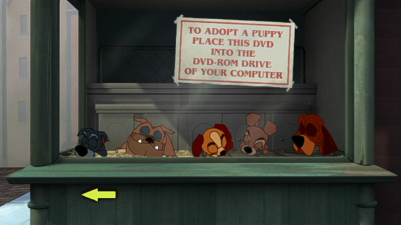
An interactive feature that springs up in a wonderfully random style, Lady And The Tramp is that rare Disney disc that does contain some added, enhanced for PC DVD-ROM content. We get a link to play the disc’s contents, (which, as usual with the InterActual player, crashed my system), but supposedly the big draw is the Adopt A Virtual Puppy feature mentioned above, with added printable features such as your own certificates of ownership. The idea is to look after your pup, animated in what appears to be Flash animated caricatured versions of the film’s stars, with a meter reading letting you know how you’re getting on. I suppose it’s cleverly conceived, fluidly animated (albeit using odd looking versions of the characters) and would be fun for tiny ones, but I also found it to be a bit of a time waster and there doesn’t seem to be a way to finally total up all the meters and I wasn’t going to stick around and see what happened if I let my pup perish! Some Wallpapers and Screensavers using the same slightly weird looking Flash-style versions of the characters round out the interactive fun.
In wrapping up, one point that must be raised is that, annoyingly, the menus (which are otherwise very attractive and nicely reproduce art from the film in a three-dimensional context) are all 16×9 anamorphically enhanced, while all the content apart from the stills gallery is good old, standard 4×3 full-frame. Surely it wouldn’t have been a problem to keep things more uniform here?

Overall it’s a nice package, but perhaps predictably and obviously there’s nothing on Lee’s public sprat with the Studio over the rights to her vocal performance which, at the time of her signing, did not include home video reproduction rights. She was awarded $3.83 million in 1991, after a lengthy court case that opened the gates for other artists to re-negotiate their contracts, most famously the wife of The Jungle Book’s King Louie, Lois Prima, which remains a political Disney Studio hot potato even to this day.
Case Study:
A big deluxe box set as per The Lion King, Aladdin and Cinderella? No? Then howsabout a nice slipcase that opens up like a book to reveal the disc contents? Nope again? Well, what about a nicely embossed/raised foiled covering? Oh, okay then, I guess we’ll have to settle for the bog standard, flat cardboard reproduction of the sleeve artwork. Disney loses points again for changing the style design of the Platinum series, going from simple dual-sized keep case for Snow White, up to slimline but nicely slipcased art for the rest of the line and a mix between large sized box sets for collectors on the selected end of year gift titles. While a slipcase is always a nice bonus for initial print runs, this one feels a bit plain after what we have been treated to before.
Inside, we get a paper printed DVD Guide, which breaks down the contents, and some copies seem to come with the latest Disney DVD Insider magazine specially tailored to the top releases, though mine did not contain this issue, sadly, so I can’t say whether it’s worth seeking out or not. As a collector, it’s a shame that all copies have not been provided with this, as the last two have been quite good fun.
Ink And Paint:
Simply…stunning, and the result of an exceptional clean up by Lowry Digital Images, now seemingly a division of the DTS company that produces the high-end motion picture soundtracks for theaters and DVDs. Unlike the slightly cropped 2.35:1 Limited Issue and previous LaserDisc incarnation, the complete 2.55:1 frame has been restored here and looks gorgeous. The hype is true when it says this is the best the film has ever looked. For those with the Limited Issue or restored LaserDisc editions of the film, you’ll even find a little added to the sides here.
Now…the bad news. Made in 1955, Lady And The Tramp was the first animated feature created for the CinemaScope widescreen format. Just as Pixar have issued additional “full-screen” versions of their widescreen films for traditional, 4×3 home video viewing, Walt was well aware that many theaters had not completed the conversion process over to the new widescreen formats. Along with this, the in-roads into television were already seeing classics such as Dumbo being readied for their television broadcasts, and Walt knew Lady And The Tramp’s destiny was television re-runs. So two versions were composed on the animation camera stands: the “official” 2.55:1 CinemaScope edition, and a second, almost just as official 1.33:1 Academy, or TV-shaped, version. Not just a cropped version of the movie, but an entirely alternatively framed edition, just as valid for its intended use.
Disney of today, in their wise choice, have decided NOT to give us a chance to see this version here, plumping instead for a simple pan-and-scan (read: cropped) hacking which loses more than half of the originally intended image. I, among many, have found this to be a huge disappointment that really would have bolstered the collectibility of this DVD and provided a truly authentic and unusual reason for including two versions of the film in the set.
Apparently, this was down to cost, but the fact is that a restored print of the Academy version does exist, having popped up on LaserDisc format when the film was issued in two separate editions in the 1990s. This previous restoration might not have looked quite as pristine as the widescreen version included here, but would have been infinitely more preferable than the totally redundant waste of space represented by this lobbed-off picture job. True, two versions might have had to have been cleaned up, but surely it was worth the cost to shift the funds spent on creating the pan-and-scan and put them towards preserving another piece of animation history, adding a significant piece of material to the so-called Platinum editions, and providing the television distribution arm with a new TV master along the way?
I’m sure you’ll get my drift, but all I can say is that this one majorly missed opportunity to not only maintain a company asset, but also boost this otherwise under-nourished DVD edition and present a version of the film that had not been seen in over 40 years before its debut on LaserDisc a decade ago. Top marks for the widescreen transfer, but the crop is a worthless dead dog. Check the images of the menacing dogs and Tony’s serenade within this review to see the differences between the widescreen, cropped and Academy versions of the movie frame.
Scratch Tracks:
With Lowry Digital now a DTS company, we might have expected the same from the audio department. Alas, DTS has not been allowed to tinker with the sound here, but we do get a Disney Enhanced Home Theater mix that boosts the original’s stereo surround and amplifies it for today’s Dolby systems. And it sounds pretty good for a 50 year old soundtrack, with a nice spread and limited but fun surround activity stemming from the original’s multi-track mixing.
For the purists, an original theatrical soundtrack is said to be included, but this isn’t strictly true: it’s only the Stereo mix that accompanied the film in Academy ratio theaters – not the surround mix that would have been featured with CinemaScope engagements – that was previously encoded for the Dolby Digital tracks on the Limited Issue and LaserDisc editions. Great, we get the full-frame audio, but not the actual widescreen track! Still, the new 5.1 re-mix is a well-enveloping nod to both, and as such is probably the sound to go for; there was certainly nothing objectionable or gimmicky about it. Original French and Spanish dubs are also included.
Final Cut:
It’s a tough call as to whether this or Cinderella from last year has received the lightest Platinum treatment so far. In Cinders’ favor was the deluxe box set, which offset any complaints against packaging at least. While those who had the limited CAV LaserDisc set had a severe sense of déjà vu, the original Lady And The Tramp edition on LD only featured limited extras at best, so anything here was always going to be a bonus. As such, the totally redundant cropped transfer, music video and games all feel a bit light and overload the set slightly towards the kid-market as opposed to the collector. In addition, Disney loses points for the lack of decent and Platinum-consistent packaging, and that alternate Academy version.
In closing, I can only say that the excellent film wins all the points here, and surely that’s the reason for picking up a DVD purchase in the first place. Marks do go to the teams responsible for the supplementary documentary features which, however slight and leaning on the same archive footage as repeated several times in the set and on the testaments of the current (or what’s left of them) Disney animators, do their best to create a satisfying look behind the scenes. So, top marks for the movie, and only adequate marks for the extras, but make no mistake – jack the pointless full-screen atrocity and see this review as a certain recommendation for a smattering of welcome archive television segments and, of course, the wonderfully original movie!
 | ||
 |







